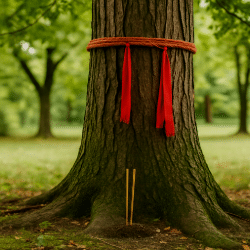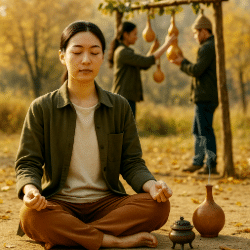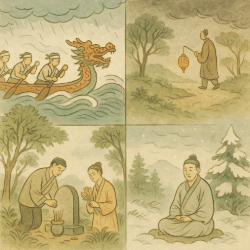Introduction
For thousands of years, people in China and beyond have treated trees as more than just part of the scenery. In Taoist tradition, they are living companions — quiet teachers that link the human world with the rhythms of Heaven and Earth.
If you’ve ever stood under a tree and felt calmer, more grounded, or quietly inspired, you’ve already brushed against this way of seeing. Taoist practices simply make that connection intentional.
The beauty is that you don’t need a temple courtyard or a mountain forest to take part. Whether you’re in a rural grove or on a balcony in the middle of a city, these practices can help you honor a tree in ways that feel meaningful and alive.
1. Silent Presence – The Foundation
One of the simplest and most universal rituals is to simply be with a tree.
In the past: Farmers might rest under a tree after the midday meal, close their eyes, and give a small bow before moving on — a gesture of thanks for shade and shelter.
Today: You can do the same in a park, your yard, or even next to a potted tree on your balcony.
Try this:
Find a safe, welcoming tree.
Stand or sit quietly nearby for 5–15 minutes.
Let your breathing slow and your attention expand to include the tree.
End with a bow or palms together in thanks.
2. Offering Breath and Qi
Taoist breathing practices often treat the exchange of breath with a tree as an exchange of life force, or qi.
Historically: Elders would greet the community’s “guardian tree” each morning, exhaling toward it as if nourishing it, and inhaling its vitality in return.
Modern version: A quick revitalization break in a green space, even during a busy workday.
Try this:
Stand facing the tree.
On each exhale, imagine sending it clear, positive energy.
On each inhale, imagine receiving its grounded, steady energy.
Repeat for at least 9 breaths.
3. Circling the Tree
Walking around a tree is a way to bring your body into harmony with its energy.
Sect traditions:
In the 4 Ascendant Tradition, circling is a way of “reading” the tree’s qi.
In Quanzhen Taoism, it may be paired with short scripture recitations.
Lay tradition: Pilgrims would sometimes circle shrine trees three times clockwise for blessing, then three times counterclockwise for protection.
Try this:
Circle the tree three times clockwise (yang), then three times counterclockwise (yin).
Move slowly and breathe evenly.
End with palms together and a bow.
4. Binding & Symbolic Connection
In many places, trees are honored with a visible sign of connection.
Red thread or ribbon:
Then: During festivals, people tied red thread or ribbon to sacred trees as prayers or vows.
Now: Eco-safe ribbons or biodegradable cord can serve the same purpose, even in city parks.
Rope binding:
Then: In temple or village customs, a rope around the trunk marked it as sacred and protected.
Now: A simple natural fiber rope, sometimes braided with charms, can be used for special occasions or blessings.
Try this:
Choose a healthy tree and make sure you have permission if it’s not yours.
Tie your ribbon or rope with a clear, focused intention in mind.
Decide how long it will stay — a season, a year — and remove it respectfully when the time comes.
5. Incense and Libation Offering
Offering incense or a libation is a direct way of saying “thank you” to the tree’s spirit.
Historically: People might light incense and pour tea or water at the base of a guardian tree during market days or seasonal festivals.
Modern version: Where incense isn’t practical (or fire safe), use flowers, fruit, or even a symbolic cup of clean water.
Try this:
Place incense in a safe, non-damaging holder near the tree.
Pour a little tea or water into the soil near the roots.
Offer a bow or a few quiet words of gratitude.
6. Full Taoist Tree Rite
A full rite is more elaborate and usually reserved for major occasions, like festivals or personal milestones.
What it might include:
A small altar near the tree.
Invocation of local spirits or deities.
Rope boundary marking to set the space apart.
Chanting, talisman placement, and blessing gestures.
Parallel in the past: Some villages held seasonal ceremonies where everyone gathered to honor a “guardian tree” with offerings, music, and food.
7. Rural vs. Urban Adaptations
Rural settings:
Large, mature trees with open space.
Time rituals to the seasons or solar terms.
Rope-binding and incense are easy to manage.
Urban settings:
Potted trees, park trees, rooftop gardens.
Use symbolic offerings and subtle gestures.
Consider public etiquette and environmental care.
8. Cultural and Historical Layers
Temple traditions: Zhengyi (formal altar rites), Quanzhen (scripture recitations), 4 Ascendant Tradition (qi-field diagnostics).
Lay traditions: Red thread prayers, libations, seasonal gatherings.
Regional differences:
Northern China: red thread for vows.
Southern China: incense in hollows.
Coastal areas: rope binding for storm protection.
Closing Thoughts
Honoring a tree doesn’t have to be complicated. What matters most is sincerity and respect — for the tree itself, the land it grows on, and the tradition you’re drawing from.
You might stand in silent presence beside a maple in your neighborhood, or take part in a full rite beneath an ancient oak. In both cases, you’re participating in a living current of Taoist practice, one that invites connection not just with nature, but with the still, enduring center inside yourself.
FAQs – Honoring a Tree in Taoist Practice
What’s the simplest way to honor a tree?
Stand or sit quietly beside a tree for 5–15 minutes, breathe naturally, and end with a small bow or palms together in thanks.
Can I do this in a city park or on a balcony?
Yes. Adapt the practice to potted trees, rooftop gardens, or public parks. Use subtle gestures and symbolic offerings like water or flowers.
What does tying a red thread or ribbon mean?
It’s a vow or prayer tie—a visible symbol linking your intention to the tree. Use biodegradable ribbon and remove it respectfully later.
Is rope binding appropriate?
Only with permission and when it won’t harm the tree. Natural fiber rope can mark a temporary sacred space during a rite; avoid constricting the trunk.
What if I can’t use incense or fire?
Offer clean water, tea, flower petals, or a written vow. The sincerity of the act matters more than smoke or flame.
How long should a practice session last?
Start with 5–15 minutes for silent presence or breath exchange. Formal rites can run 20–40 minutes depending on steps and group size.
Are there lineage variations?
Yes. Quanzhen may add short recitations; Zhengyi may use altar steps; the 4 Ascendant Tradition reads and seals the tree’s qi at the end.
Any ethics I should follow?
Get permission for public or private trees, avoid damage, use biodegradable materials, pack out offerings, and prioritize the tree’s health and safety.



